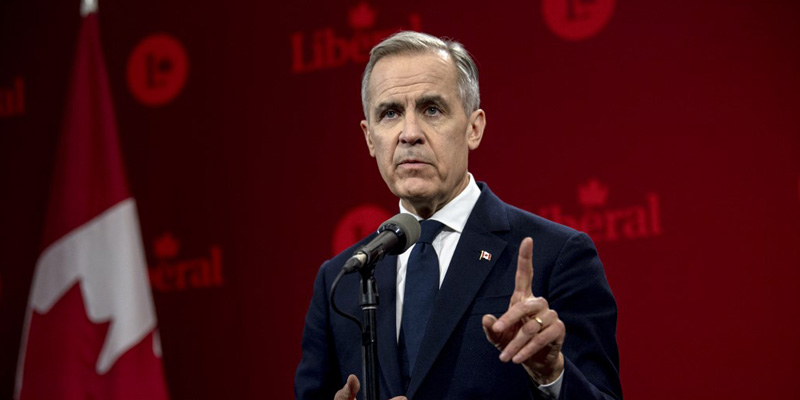- World
- Apr 30
Mark Carney’s Liberals win Canada election
• Canadian Prime Minister Mark Carney and his Liberal Party won the federal election and retained power, capping a stunning turnaround in fortunes fuelled by US President Donald Trump’s annexation threats and trade war.
• Carney was elected Liberal leader in March, replacing former Prime Minister Justin Trudeau, who resigned amid low approval ratings after nearly a decade in office.
• Carney anchored his campaign on an anti-Trump message.
• Trump’s threats ignited a wave of patriotism that swelled support for Carney. Trump re-emerged as a campaign factor after declaring he might raise a 25 per cent tariff on Canadian-made cars because the US does not want them. Trump said earlier he might use economic force to make Canada the 51st state.
• Carney has emphasized that his experience handling economic issues makes him the best leader to deal with Trump.
• The departure of former PM Trudeau was also crucial to the Liberal win, which capped one of the most dramatic turnarounds in Canadian political history. Carney distanced himself from Trudeau throughout the campaign.
• Carney’s rival, populist Conservative Party leader Pierre Poilievre, was voted out of his seat in Parliament.
• It is the Liberal Party’s fourth victory since 2015 though its race against the Conservative Party was much tighter than anticipated by the opinion polls.
• The Liberals were leading or elected in 167 electoral districts, known as seats, followed by the Conservatives with 145, with votes still being counted. The Liberals had needed to win 172 of the House of Commons’
343 seats for a majority that would allow them to govern without support from a smaller party.
• If they don’t win a majority in Parliament, the Liberals might need to rely on one of the smaller parties.
• Minority governments in Canada rarely last longer.
• Carney and the Liberals secured a new term, but they have daunting challenges ahead.
• Carney had promised a tough approach with Washington over its import tariffs and said Canada would need to spend billions to reduce its reliance on the US.
• In addition to the trade war with the US and frosty relationship with Trump, Canada is dealing with a cost-of-living crisis. And more than 75 per cent of its exports go to the US, so Trump’s tariffs threat and his desire to get North American automakers to move Canada's production south could severely damage the Canadian economy.
Who is Mark Carney?
• Carney, 60, was born in Fort Smith, Northwest Territories, on March 16, 1965, and raised in Edmonton, Alberta.
• He received a bachelor’s degree in economics from Harvard University in 1988. He went on to receive a master’s degree in Economics in 1993 and a doctorate in Economics in 1995, both from Oxford University.
• Carney is a former Goldman Sachs executive. He worked for 13 years in London, Tokyo, New York and Toronto, before being appointed deputy governor of the Bank of Canada in 2003.
• Carney ran the Bank of Canada from 2008 to 2013 and the Bank of England from 2013 to 2020. After helping Canada manage the worst impacts of the 2008 financial crisis, he was recruited to become the first non-Brit to run the Bank of England since it was founded in 1694.
• He became the first person to head two G7 central banks.
• In 2020, he began serving as the United Nations’ special envoy for climate action and finance.
• Carney was the first person to become Canadian Prime Minister without having experience as a legislator or cabinet member.
A fresh chapter likely in India-Canada relations
• Prime Minister Narendra Modi congratulated Canadian PM Mark Carney on the victory of his Liberal Party in federal elections.
• PM Modi said he was looking forward to strengthening bilateral ties and unlocking greater opportunities for people of the two nations.
• The ties between India and Canada came under severe strain following former PM Justin Trudeau’s allegations in September 2023 of the “potential” involvement of Indian agents in the killing of Hardeep Singh Nijjar on Canadian soil.
• New Delhi strongly rejected Trudeau’s charges.
• The relations nosedived further in the second half of 2024 after Ottawa linked several Indian diplomats including then High Commissioner Sanjay Verma to the murder of Nijjar.
• In October 2024, India withdrew Verma and five other diplomats. India also expelled an equal number of Canadian diplomats from New Delhi.
• In the last few months, security officials of India and Canada resumed contact and both sides were looking at the possibility of appointing new high commissioners. The exit of Trudeau was seen as an opportunity to improve bilateral ties.
• India had accused Trudeau’s government of allowing pro-Khalistani elements to operate from Canadian soil. After Trudeau’s exit, New Delhi said it hoped to rebuild ties with Canada based on mutual trust and sensitivity.
Manorama Yearbook app is now available on Google Play Store and iOS App Store


